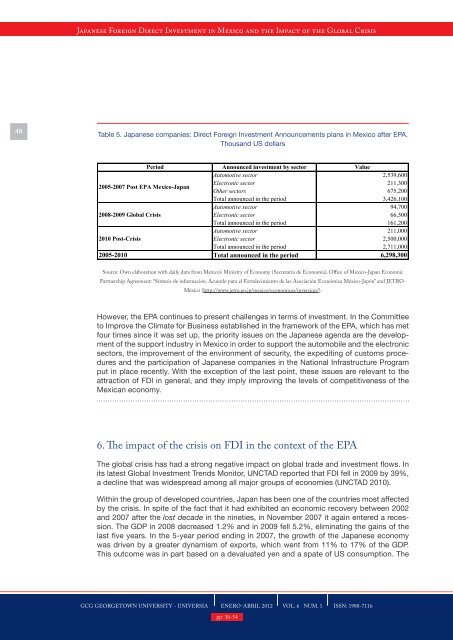Vol. 6 Num. 1 - GCG: Revista de Globalización, Competitividad y ...
Vol. 6 Num. 1 - GCG: Revista de Globalización, Competitividad y ...
Vol. 6 Num. 1 - GCG: Revista de Globalización, Competitividad y ...
Create successful ePaper yourself
Turn your PDF publications into a flip-book with our unique Google optimized e-Paper software.
Japanese Foreign Direct Investment in Mexico and the Impact of the Global Crisis48Table 5. Japanese companies: Direct Foreign Investment Announcements plans in Mexico after EPA.Thousand US dollarsPeriod Announced investment by sector ValueAutomotive sector 2,539,6002005-2007 Post EPA Mexico-JapanElectronic sector 211,300Other sectors 675,200Total announced in the period 3,426,100Automotive sector 94,7002008-2009 Global CrisisElectronic sector 66,500Total announced in the period 161,200Automotive sector 211,0002010 Post-CrisisElectronic sector 2,500,000Total announced in the period 2,711,0002005-2010 Total announced in the period 6,298,300Source: Own elaboration with daily data from Mexico’s Ministry of Economy (Secretaría <strong>de</strong> Economía). Office of Mexico-Japan EconomicPartnership Agreement: “Síntesis <strong>de</strong> información. Acuerdo para el Fortalecimiento <strong>de</strong> las Asociación Económica México-Japón” and JETRO-México (http://www.jetro.go.jp/mexico/economicas/inversion/).However, the EPA continues to present challenges in terms of investment. In the Committeeto Improve the Climate for Business established in the framework of the EPA, which has metfour times since it was set up, the priority issues on the Japanese agenda are the <strong>de</strong>velopmentof the support industry in Mexico in or<strong>de</strong>r to support the automobile and the electronicsectors, the improvement of the environment of security, the expediting of customs proceduresand the participation of Japanese companies in the National Infrastructure Programput in place recently. With the exception of the last point, these issues are relevant to theattraction of FDI in general, and they imply improving the levels of competitiveness of theMexican economy.6. The impact of the crisis on FDI in the context of the EPAThe global crisis has had a strong negative impact on global tra<strong>de</strong> and investment flows. Inits latest Global Investment Trends Monitor, UNCTAD reported that FDI fell in 2009 by 39%,a <strong>de</strong>cline that was wi<strong>de</strong>spread among all major groups of economies (UNCTAD 2010).Within the group of <strong>de</strong>veloped countries, Japan has been one of the countries most affectedby the crisis. In spite of the fact that it had exhibited an economic recovery between 2002and 2007 after the lost <strong>de</strong>ca<strong>de</strong> in the nineties, in November 2007 it again entered a recession.The GDP in 2008 <strong>de</strong>creased 1.2% and in 2009 fell 5.2%, eliminating the gains of thelast five years. In the 5-year period ending in 2007, the growth of the Japanese economywas driven by a greater dynamism of exports, which went from 11% to 17% of the GDP.This outcome was in part based on a <strong>de</strong>valuated yen and a spate of US consumption. The<strong>GCG</strong> GEORGETOWN UNIVERSITY - UNIVERSIA ENERO-ABRIL 2012 VOL. 6 NUM. 1 ISSN: 1988-7116pp: 36-54















